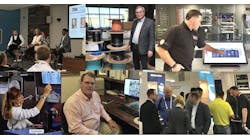Latest from Professional Development/Leadership
ISE EXPO’s Advisory Board Members Speak Their Minds
After reading our Advisory Board members’ insights on leadership, network evolution, innovation, soft skills, and embracing uncomfortable truths, I was reminded of one of my favorite quotes from Ruth Bader Ginsburg, Associate Justice of the Supreme Court from 1993 to 2020: "Fight for the things you care about but do it in a way that will lead others to join you."
These leaders share their perspectives honestly yet in a way that truly resonates. I invite you to not just hear their words but truly listen—you may discover more than you expected.
Topic: Dirty Little Secret
ISE: Share an uncomfortable truth about the fixed and/or mobile networks that our industry must confront in 2025.
Randy Alderton, Bell Canada: 5G and fiber rollouts promise unprecedented speeds and capabilities, yet a significant portion of the global population remains unconnected or underserved. This isn't simply about lacking physical infrastructure; it's also about affordability, digital literacy, and the lack of relevant content and services in certain languages or cultural contexts.
This disparity isn't just a social justice issue; it's a business one. A large segment of potential customers is excluded from participating in the digital economy, limiting market growth and hindering the full realization of the potential of advanced network technologies. Ignoring this will lead to:
- Missed Revenue Opportunities: A large, untapped market remains inaccessible.
- Increased Social Inequality: As the gap between the connected and unconnected widens, it could lead to social unrest and economic instability.
- Security Risks: Unequal access can create vulnerabilities, as unconnected populations are more susceptible to misinformation and exploitation.
- Slower Technological Innovation: A less diverse user base limits feedback and hinders the development of inclusive and truly beneficial technologies.
Failure to confront this uncomfortable truth will ultimately limit the long-term success and societal impact. The focus must shift from simply expanding coverage to ensuring equitable access and meaningful inclusion.
Francis Alueta, altafiber/Hawaiian Telcom: An uncomfortable truth is that revenue and pricing models may not be keeping up with the capital investment needed to deploy and transition existing customers to fiber networks.
John Amundson, TDS Telecom: FTTx OSP that is more complex than needed. Costs for OSP in fiber networks are too high, but not solely because of rising labor and material costs—those have historically always gone up. But it’s because we, the network owner/operators, require, design, and build with more complexity than required. The industry needs to think critically about how we are building and what is really needed to provide the services we want to sell. We need to think about simplifying design, which will, in turn, simplify engineering and construction processes. Radical simplification (my own terminology) thinking will get us the network we need and give contractors the speed and profitability needed to meet the demands of today’s fiber networks in terms of cost and speed of deployment.
David Curran, Frontier: As an industry, we probably spend as much or more time and money dealing with legacy technologies and systems than we do on our current generation. No investor wants to spend limited funds on replacing or removing "perfectly good" hardware and software, but it leads to inefficiencies and unnecessary complexity and cost.
Marc Durocher, Verizon: The uncomfortable truth about fixed wireless access is that churn is higher than traditional wired broadband connections. We need to fix this issue in order to grow the technology.
Sherry Hessenthaler, Brightspeed: The uncomfortable truth is primarily related to the ability to execute quickly in updating and expanding networks and related technology. Most deployments are faced with infrastructure challenges related to facility locating, securing access in public and private right of ways, permitting, etc., that impact deployment intervals and the ability to execute as quickly as desired.
William Kurtz, Norvado: The escalating costs of network construction are increasing at an unsustainable rate. While mobile networks are often considered a complementary solution, they are not universally viable due to environmental and logistical constraints. The industry must confront these financial and deployment challenges to ensure continued broadband expansion.
Kevin Lybrand, PC Telcom: The uncomfortable truth is that security and privacy are becoming increasingly difficult in fixed wireless and mobile networks. Cybercriminal tactics become more advanced as technology advances.
Dennis Pappas, NextLight: In our community, it is the gaps in coverage that all cell providers have.
Michael Wilson, Meta: The uncomfortable truth in fixed/mobile networks is that the overall decline in skilled labor directly results from poor training and management.
Topic: Innovation
ISE: If you could wave a magic wand, what groundbreaking product or solution would you like to see showcased at ISE EXPO 2025?
Alderton: I'd wish for a truly seamless and universally interoperable AV-over-IP ecosystem.
Currently, the AV-over-IP space suffers from fragmentation. Different manufacturers use proprietary protocols and codecs, making integration complex, expensive, and often unreliable. This limits scalability, flexibility, and the potential for innovative applications.
My magic wand solution would be a standardized, open-source protocol and a suite of tools that allow any AV device, regardless of manufacturer, to seamlessly connect and communicate over a standard IP network.
Such a universally interoperable AV-over-IP ecosystem would truly be a game-changer, showcasing the potential of IP technology to transform the AV landscape. It would be the highlight of ISE EXPO 2025, demonstrating the power of collaboration and standardization in driving technological advancement.
Alueta: I would like to see the use of blockchain technology for secure network transportation and decentralized networks (e.g., data centers) and the implementation of AI that drives resiliency with self-optimizing networks.
Amundson: I would like to see a universal system used for municipality (local, state, and federal) permitting that ties their GIS records to our GIS plans for a simple, low-cost high-speed way for both parties to be on the same page about construction requests and construction progress. It would require integration on a large scale, but the benefits would be amazing. AI is driving more and more system-to-system knowledge transfer, so this idea seems like an excellent use of that technology.
Curran: Believe it or not, ways to prevent copper theft! With all the talk about fiber, copper theft is still a huge problem and results in not only expensive replacements but also outages for customers and first responders. I'd love to see some solutions that not only make it harder to steal the cable, but also harder to sell and process it.
Durocher: Passive geolocation. A way for the customer to follow an AR roadmap to the passive equipment within their home, like a fiber access port.
Hessenthaler: Showcasing innovative, groundbreaking products or solutions would allow us to quickly and economically transition services from antiquated networks (like copper networks or discontinued networking equipment) to alternative and advance technology solutions.
Kurtz: I would like to see innovations that significantly enhance the efficiency of fiber optic construction. Specifically, solutions that accelerate the deployment process—whether through advancements in plowing technology, automation, or streamlined permitting—would have a transformative impact on the industry. The question remains: How can we make fiber deployment faster without compromising quality or cost-effectiveness?
Lybrand: I would like to see more about AI. How can we integrate this to help with real-time analytics, automated troubleshooting, and predictive maintenance?
Pappas: City wide Wi-Fi so your always connected to our network.
Wilson: If I had a magic wand to wave, I would see more on hollow core/multi core fiber.
Topic: Constant Growth
ISE: What soft skills and leadership strategies are essential for achieving your future career goals in an evolving industry?
Alderton: To succeed in a rapidly changing technological landscape, a professional needs a strong foundation in both technical expertise and crucial soft skills.
Essential Soft Skills:
- Adaptability and Continuous Learning: The pace of technological change is relentless. The ability to quickly learn new technologies, adapt to new workflows, and embrace change is paramount.
- Communication and Collaboration: Collaboration is crucial in team-based projects, requiring strong interpersonal skills and the ability to work effectively with diverse individuals.
- Problem-Solving and Critical Thinking: This includes a willingness to question assumptions and explore alternative approaches.
- Creativity and Innovation: Generating new ideas and exploring unconventional solutions is crucial for staying ahead of the curve.
- Resilience and Perseverance: These skills are necessary to maintain motivation and overcome obstacles.
- Emotional Intelligence: Understanding and managing one's own emotions and understanding the emotions of others is crucial.
There are also essential Leadership Strategies that include empowering and mentoring, being agile and adaptable, using data to inform decisions, cultivating knowledge sharing and creating a diverse and inclusive team.
By focusing on these soft skills and leadership strategies, professionals can significantly enhance their ability to navigate the complexities of a rapidly evolving industry and achieve their career goals. These skills are not just beneficial, they are increasingly necessary for success.
Alueta: Leaders need to clearly articulate an organization’s goals and the vision they have for people and the organization to achieve them. Always have open and transparent communications across all levels of the organization.
Amundson: In my view, leaders must be adaptable to change, comfortable with ambiguity, and continuously learning. Think of those three things flowing from one to another—call it the waterfall of managing and adapting to the unknown. The workplace dramatically changed thanks to the COVID-19 pandemic, but that change was coming. It was inevitable, given the pace of technology; COVID-19 just sped it up. We are in the remote work environment now and will stay in it. There isn’t a practical way back to the “old days,” nor should there be.
Going forward, adaptation is key to managing, as this type of environment will only lead to more challenges and more ambiguity. Dealing with ambiguity certainly goes hand in hand with adaptation—much like the time-honored chicken and egg quandary. Continuous learning is like the windshield washer fluid that adds clarity to the situation. But don’t relegate continuous learning to only academic pursuits. Instead, broaden the definition to include learning about people, ideas, cultures, and points of view. The workplace is a far more fluid environment than it once was, requiring us to spend more time learning how it all fits together to effectively lead.
Curran: As a technical leader, I'd say "listening." We tend to be as opinionated about technology as we are about cars or sports teams. It's entirely possible, though, that someone on your team or in the industry had a better idea. Fostering open communication and listening is the only way to stay grounded and keep current with fast-paced technology change.
Durocher: Engaging in more valuable networking opportunities with other industry leaders.
Hessenthaler: Soft skills like the ability to listen and learn. Leadership strategies related to facilitating innovation and execution across cross-functional disciplines or business entities are critical as well.
Kurtz: Adaptability and strategic foresight are critical in a rapidly evolving telecommunications landscape. Leaders must be able to pivot strategies in response to regulatory shifts, technological advancements, and economic pressures. Additionally, fostering cross-functional collaboration and maintaining a data-driven decision-making approach will be essential to driving long-term success.
Lybrand: Some soft skills I believe are key for our changing workforce needs are adaptability, emotional intelligence, and communication. As leaders, we have to be visionaries and have agility in decision-making. We also need to invest time in mentoring and coaching if we are going to sustain growth in this rapidly changing industry.
Pappas: You must build a team whose members’ attributes complement each other. You must also have relative experience in community operations to share and teach other team members.
Wilson: I think empathy is the best soft skill, and humility is the best leadership strategy/skill for moving forward. Knowing when to admit you don't know or are wrong is critical to learning and building trust with a team.
Advisory Board Bios
Randy Alderton
Network Provisioning Specialist FTTH - MDU
Bell Canada
Francis Alueta
Director III - Network Technology, Engineering and Operations
altafiber/Hawaiian Telcom
As Director Network Technology, Engineering and Operation, Francis Alueta is responsible for new technology introduction and Tier 2/3 support of alftafiber’s and Hawaiian Telcom’s state-of-the-art Core, Edge, Access, Voice & Video networks. Prior to his current position, he served as Director – Network Reliability, responsible for the day-to-day operations of Hawaiian Telcom’s 24/7 state-of-the-art Network Operations Center, Hawaiian Telcom TV head end operations, 911 operations, Tier 2/3 technical support and capacity planning and engineering, driving customer satisfaction and network performance. He also manages the team that serves as the primary Network Operations Center for the Southeast Asia – United States (SEA-US) trans-Pacific undersea fiber cable system that provides the fastest direct access between the U.S., the Philippines and Indonesia.
John Amundson
Director - Network Planning & Implementation
TDS Telecom
John leads the regional planning, construction project implementation, and OSP innovation and testing teams for TDS Telecom. He oversees network planning and design and project construction management to support the company’s aggressive fiber expansion efforts. He also has responsibility for OSP materials and process innovation leading TDS to lowering build costs. John has been with TDS Telecom for more than four decades and held numerous positions with increasing responsibility. In 2017, John was responsible for the first patent in TDS’ history. He patented a method of constructing fiber-to-the-home networks incorporating connectorized optic fiber tab assembly. John is now listed on four patents associated with the process.
David Curran
Vice President, Network Architecture
Frontier Communications
With a telecommunications career spanning over two decades, David has held many roles in network engineering, operations, and IT. After joining Frontier Communications in 2014, he worked in diverse areas such as NG911, network automation, and network strategy. Prior to joining Frontier, David held several architecture and strategy roles at Windstream and NuVox. His focus has always been the intersection of emerging technologies and business objectives, crafting long-term strategies that cater to company goals. Since 2019, David has led the Network Architecture team and its Fiber Innovation Lab where he leads teams that design, test, and certify all new voice, broadband, core, transport, and wireless technologies.
Marc Durocher
Director
Verizon
Marc is a Director in Verizon’s Global Network and Technology team responsible for business operations support, new product deployments, process innovations, and driving innovation across multiple field organizations. He is a certified Lean Six Sigma Black Belt and has held leadership roles within the telecommunications and insurance industries and his projects have generated millions of dollars in annual savings by eliminating waste and creating sustainable solutions to complex problems. Marc graduated from Saint Anselm College and earned his MBA from Nichols College, where he received an academic excellence award for graduating first in his class.
Sherry Hessenthaler
Chief Corporate Development Officer
Brightspeed
William Kurtz
Director of Engineering and Construction
Norvado, Inc.
William G. Kurtz, PE, with over 26 years of experience, has distinguished himself as a leader in engineering and construction. As the Director of Engineering and Construction at Norvado, he has showcased expertise in project analysis, budgeting, and strategic reporting. His leadership roles at the Wisconsin Department of Natural Resources and the Wisconsin Department of Transportation highlight his ability to oversee diverse projects, implement advanced management systems, and ensure quality assurance. As the founder of Chequamegon Bay Group, Inc., William demonstrated entrepreneurial acumen, growing the firm significantly and securing contracts worth over $150,000,000. His advocacy led to the State of Wisconsin designating a Service-Disabled Veteran Category for business classification.
Kevin Lybrand
CEO/GM
PC Telcom
Kevin is the CEO of PC Telcom in Holyoke, CO, where he manages the company’s overall operations with a focus on strategic growth and customer engagement. Prior to joining PC Telcom, he served as the Construction and Engineering Manager for Chariton Valley Communications in Macon, MO. After proudly serving in the United States Army, Kevin transitioned back to Arkansas, taking a position as a truck driver and eventually owning his own trucking company. After a decade in trucking, he seized the opportunity to enter the telecommunications industry as an Installation and Repair technician at Southwestern Bell. Over his 24-year career, Kevin advanced to supervisory and management roles at AT&T and CenturyLink, working across diverse markets in Arkansas, California, Texas, Florida, Missouri, and Colorado.
Dennis Pappas
Director - Fiber Network
NextLight
Dennis' experience in the field of communications spans 48 years and what he enjoys most in working in this industry is the constant change and the speed at which it occurs. In 2021, he joined the NextLight team and is currently the Director of their fiber network. He is focused on expanding their service suite while continuing to maintain and expand the fiber network in Longmont which currently covers 90+% of the City with fiber (46,000 premises) while providing Gig and Gig+ services to more than 27,500 customers which includes more than 1,300 commercial customers. He has held a number of leadership positions in the industry in Network Operations, Engineering, Product Development, Technical Regulatory and Public Policy but by far the most enjoyable experience to date has been with NextLight and the customers.
Michael Wilson
Connectivity Engineer
Meta
With his 18 years of industry expertise, Michael specializes in complex infrastructure construction, maintenance and design. From CATV systems, copper infrastructure, fiber builds, microwave networks and hyperscale data center development, he is a highly accomplished telecommunications expert. Utilizing a unique blend of hands-on experience and executive oversight, he delivers exceptional results. Committed to fostering innovation and excellence, he actively mentors and shares knowledge to empower the next generation of professionals.

Sharon Vollman | Content Ambassador for ISE EXPO
Sharon Vollman is the Content Ambassador for ISE EXPO. She is passionate about collaborating with thought leaders, SMEs and hard-working doers who design, plan and deploy ultra-reliable broadband networks. Vollman is committed to creating a variety of educational offerings for ISE EXPO attendees that inspire them to connect every U.S. citizen with the broadband networks we all want for our children and grandchildren.
Vollman has created educational partnerships with Broadband Service Providers including AT&T, Verizon, Lumen, Frontier Communications and others. She has covered the telecom industry since 1996.














